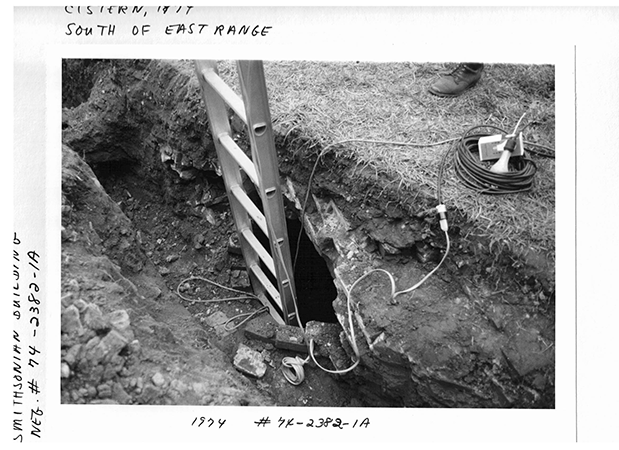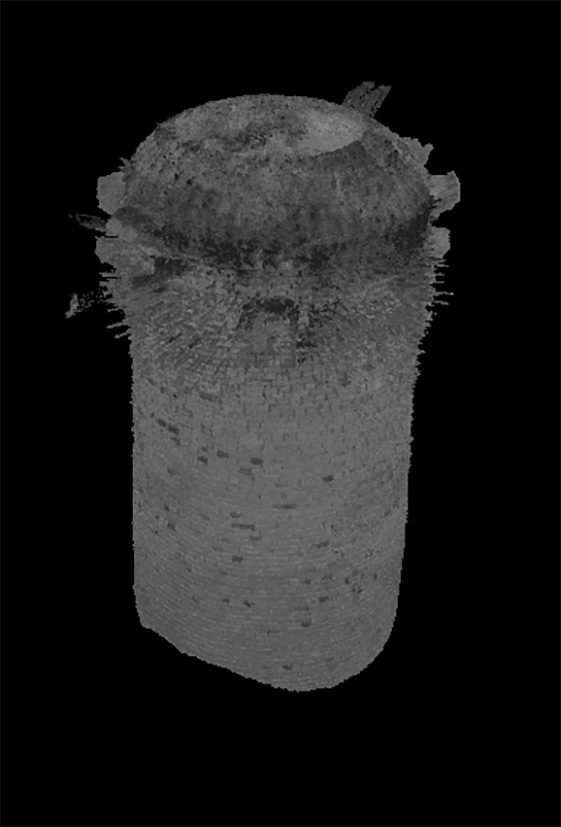Discovering a Castle Cistern
By Carly Bond
In August 2024, during excavation work for the Revitalize Castle project near the Smithsonian Institution Building (Castle) in Washington, DC, a below-grade brick masonry cistern was discovered. This unanticipated finding was located about 45 feet east of the Castle’s porte cochere and about four and a half feet beneath the Jefferson Drive roadbed.
360° View of the Castle Cistern
Institutional knowledge on the existence of the cistern was lost and recovered through object documentation and archival research. Three in-ground cisterns were constructed with the Castle circa 1847. These cisterns collected overflow of rainwater from cisterns located inside the roofs of the Castle’s east and west wings. When the Castle was originally constructed, it utilized a self-sufficient water and wastewater system, even servicing interior bathrooms, until the building was connected to the DC public water system in 1865.i
Two cisterns are located north of the Castle, including the uncovered cistern east of the Castle’s north entrance. The second northern cistern, if it still exists, is in an undetermined location. The third cistern was discovered in 1974 located south of the Castle’s east wing. This cistern was infilled and remains in its current location but was forgotten until the August 2024 discovery.

The rainwater harvesting cisterns were constructed as brick cylinders, measuring nine feet in diameter and up to 30 feet in depth. They were originally covered in wood planks and soil but due to concern of wood deterioration and damage from carriages they were domed with “mortared brick” in 1857. One of the cisterns was converted for use as an icehouse in 1857.ii One of the cisterns was converted for use as an icehouse in 1857. The discovered cistern contained approximately 15 feet of soil and debris that did not contain any significant artifacts or archaeological resources. The Smithsonian and National Park Service assessed the cistern, and record documentation was completed by the Smithsonian’s Office of Planning, Design, and Construction. The cistern was laser scanned and photographed with 360-degree imagery.

Due to the unknown structural integrity of the cistern and the significant void it created under the Jefferson Drive roadbed, for vehicular and public safety the cistern was filled. A portion of the cistern was demolished due to conflicting utility and telecommunication line work. Brick from the cistern was salvaged and is currently in Smithsonian storage for use in an outdoor exhibit in development at the location of the Castle’s south cistern. This exhibit will be installed with the completion of the Revitalize Castle project circa 2030.
The Smithsonian Institution plans to complete ground penetrating radar or other testing to try and locate the third cistern. If successful, AHHP will provide this information through a future issue of the Preservation Periodical. Due to the historic concerns of carriages breaking through the cisterns’ original wood roofs, the Smithsonian presumes the third cistern is likely located somewhere in the historic carriage path, what is now Jefferson Drive.
[i] Smithsonian Institution, Journals of the Board of Regents, Reports of Committees, Statistics Etc., 1846-1876, pages 659-660.
[ii] Smithsonian Institution, Annual Report of the Board of Regents Showing the Operations, Expenditures, and Condition of the Institution for the Year 1857, page 71.